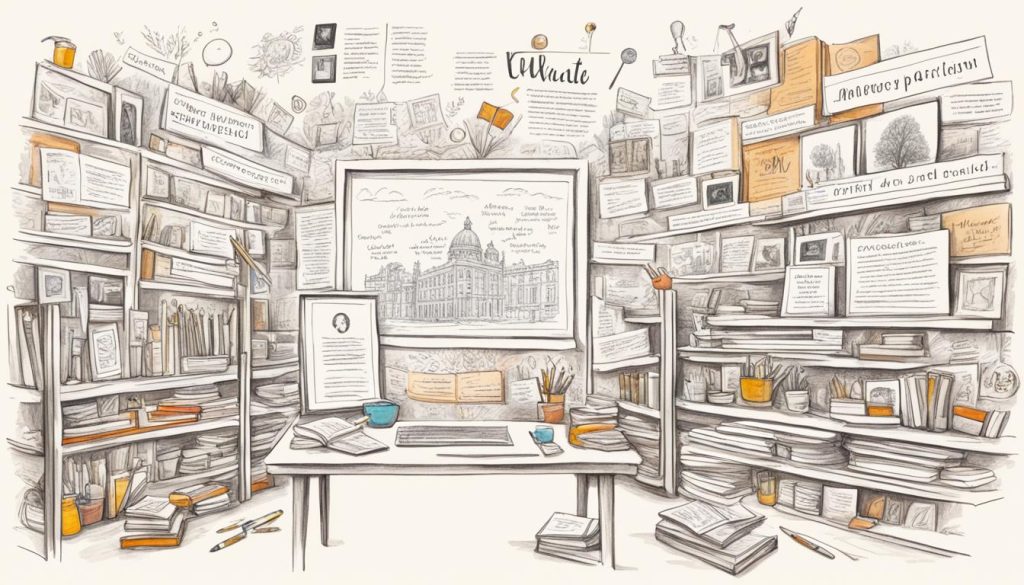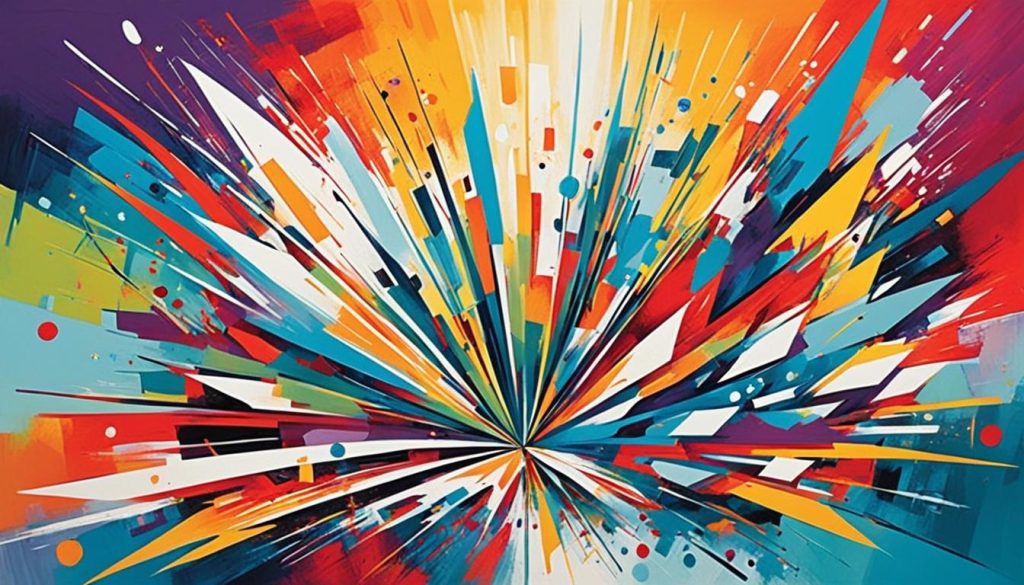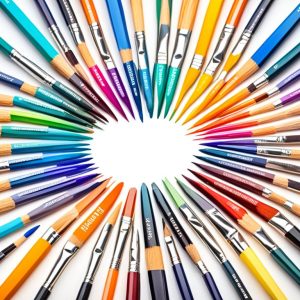Welcome to my guide on crafting an artist bio that will captivate potential collectors and make them eager to learn more about your art. Your artist bio is a powerful marketing tool that serves as a window into your creative journey. It’s often the first piece of information that collectors encounter, offering a summary of your portfolio and resume. By following the tips and best practices I’ll share here, you’ll be able to create a compelling artist bio that leaves a lasting impression.
Key Takeaways:
- Craft an artist bio that captures the attention of potential collectors.
- Include key information such as your medium, themes, influences, and techniques.
- Express your unique voice and avoid underselling yourself.
- Create artist bios of varying lengths to suit different platforms.
- Consider utilizing AI tools to improve and personalize your artist bio.
(Note: The image showcases an artist’s bio as an example and is for illustrative purposes only.)
The Importance of an Artist Bio
An artist bio holds significant importance as a powerful tool to capture the attention of collectors, gallerists, brand partners, and more. As the first piece of information available to both current and prospective collectors, it serves as a window into your artistic journey and a summary of your resume and portfolio.
A well-crafted artist bio has the ability to pitch yourself effectively, showcasing your talents and unique creative journey. It provides valuable context and perspective to your work, enabling potential collectors and partners to gain a basic understanding of who you are as an artist, and leaving them with a strong desire to know more.
“The artist bio is a marketing tool that intrigues and engages, acting as a bridge between you as the artist and those who appreciate your work”
Think of your artist bio as a marketing tool that entices and captivates the viewer. It opens the door to a deeper connection between you and your audience, laying the foundation for a meaningful relationship. By showcasing your journey and the story behind your creations, your artist bio becomes a gateway to establishing a personal and emotional connection.
For example, when crafting your artist bio, use engaging language to describe your artistic development and influences. Highlight significant milestones, significant exhibitions, and achievements that contribute to your creative narrative. This enables potential collectors to see the evolution of your work, understand your artistic vision, and appreciate the depth and thoughtfulness behind your creations.
As an artist, you have a unique voice and perspective, and your artist bio is an opportunity to communicate that. Use your bio to convey your passion, philosophy, and the intention behind your art. Articulate your motivations, inspirations, and the story you wish to tell through your work. This personal touch enables collectors to connect with you on a deeper level, creating a lasting impression and a desire to explore further.
Remember, an artist bio is not just a summary of your artistic journey; it is a marketing tool that represents you and your work. It gives potential collectors and partners a glimpse into your creative process, your accomplishments, and your aspirations. By crafting its content thoughtfully and leveraging its storytelling aspect, you can create an artist bio that not only captures attention but builds a bridge between you and those who appreciate and support your art.
Key Ingredients of an Artist Bio
A successful artist bio is like a recipe that incorporates key ingredients to summarize your artistic practice. Just as a dish requires the right combination of flavors, your bio should showcase the elements that define your unique artistic journey and style. Let’s explore the key ingredients that make up a compelling artist bio.
Medium
Your chosen medium is a fundamental element to include in your artist bio. Whether you specialize in painting, sculpture, photography, or any other medium, it sets the foundation for your artistic identity. Highlighting your medium provides insight into your artistic process and helps potential collectors understand the tools and techniques you employ to create your art.
Themes, Influences, and Inspirations
Art is often influenced by various themes, inspirations, and experiences. Including these in your bio helps potential collectors connect with your work on a deeper level. Are you inspired by nature, history, or social issues? Do certain artists or movements spark your creativity? Sharing these influences adds depth and context to your art, inviting viewers to appreciate the layers of meaning behind your creations.
Techniques
Highlighting your artistic techniques in your bio gives collectors a glimpse into your artistic process and showcases your technical expertise. Whether you focus on traditional methods or experiment with innovative techniques, sharing this information demonstrates your skills and mastery. It also adds another dimension to the story of your artistic practice.
Pro Tip: Be selective when including achievements and accolades in your bio. While they are important, they should complement rather than overshadow your artistic identity and work. Highlight accomplishments that provide a good representation of your achievements, without overwhelming the reader with an exhaustive list.
Showcasing these key ingredients in your artist bio helps potential collectors connect with your work on a deeper level. By incorporating your medium, themes/influences/inspirations, and techniques, you paint a comprehensive picture of your artistic practice. Examples of artist bios that effectively highlight these elements can serve as inspiration when crafting your own bio.
Tips and Tricks for Perfecting Your Artist Bio
To perfect your artist bio, it’s important to incorporate your unique voice and maintain an honest and authentic tone throughout. Whether you choose to write in the first or third person, make sure your bio includes all the key ingredients we discussed earlier.
One essential tip is to avoid selling yourself short. Even if you’re not a full-time artist, your bio should demonstrate confidence and pride in your work. Emphasize your accomplishments and highlight what makes your artistic practice stand out.
Having bios of varying lengths is beneficial as it allows you to cater to different platforms and purposes. For example, a shorter bio can be suitable for social media profiles, while a longer bio may be more appropriate for a personal website or exhibition catalog.
Utilizing AI tools like ChatGPT can help you improve and personalize your artist bio. These tools can generate ideas, suggest revisions, and enhance the overall quality of your writing. However, it’s essential to edit and seek feedback to ensure that the final bio effectively describes you and your artistic practice.
“Incorporating my voice and staying true to myself has been key in writing my artist bio. It allows me to connect with potential collectors on a deeper level and showcase my authenticity.” – Emma Thompson, Visual Artist
Remember, your artist bio is an opportunity to make a memorable impression on potential collectors and partners. Take the time to craft a compelling bio that showcases your unique artistic journey and leaves a lasting impact.

Crafting a Clear Artistic Identity
Your artist statement plays a crucial role in showcasing your clear artistic identity and establishing an identifiable style. It is through this statement that potential buyers can gain a deeper understanding of your work and feel confident in investing in your art.
When crafting your artist statement, emphasize your confidence in your work and let your unique artistic voice shine. Clearly communicate your artistic vision and the themes or concepts that drive your creative process. This will help potential buyers connect with your art on a deeper level and appreciate the authenticity of your artistic expression.
It is also important to highlight the solid foundation of your artistic practice. Share details about your origins, educational background, and the media you work with. These elements contribute to establishing your artistic identity and provide a context for your work.
Be sure to showcase your journey as an artist by highlighting significant exhibition accomplishments, awards, and relevant training. This demonstrates your career potential and assures potential buyers that your artistic path is one of growth and success.
[“My artistic identity is rooted in my love for nature and my passion for abstract expressionism. Through my vibrant and energetic brushstrokes, I aim to capture the beauty and emotions of the natural world. Inspired by my childhood spent in the countryside, my art reflects the harmony and balance found in nature. With a solid foundation in fine arts education and several successful exhibitions under my belt, I strive to continually evolve and push the boundaries of my artistic practice.”]

Establishing a clear artistic identity is essential for artists who want to leave a lasting impression and showcase their unique style. By confidently expressing your artistic vision and highlighting your accomplishments, you can attract potential buyers and build a successful art career.
Establishing Career Potential
Career potential is a key factor to highlight in your artist bio. As an artist, it is important to clearly articulate your career goals and aspirations, painting a picture of the impact you aim to create in the art world. By emphasizing how your work contributes value and innovation, you can captivate potential buyers and showcase your ambition.
Additionally, your presence as an artist plays a crucial role in establishing career potential. Having a personal website or dedicated social media platforms allows you to showcase your portfolio, engage with your audience, and demonstrate your professionalism and commitment. This online presence acts as a window into your artistic journey, inviting potential buyers and employers to connect with your work.
Highlighting your unique qualities is another effective strategy to establish career potential. Expressing what sets you apart from other artists in your art form or genre creates intrigue and can attract attention. Whether it’s your innovative techniques, compelling subject matter, or distinct artistic style, focus on highlighting the qualities that make your work stand out.
Lastly, emphasize the importance of a good fit. Aligning your artistic identity, experiences, and goals with the needs and interests of potential buyers, employers, or organizations is crucial. By clearly demonstrating how your work aligns with their objectives, you increase the likelihood of establishing meaningful connections and securing valuable opportunities.
Remember, your artist bio is your opportunity to showcase your career potential. Communicate your goals, emphasize your unique qualities, and show how you are a good fit for the art world. With a well-crafted artist bio, you can captivate potential collectors and partners, leaving a lasting impression.
Example of a Career Goal:
“My goal is to use my artwork to inspire social change and create awareness around diversity and inclusion. Through my creations, I aim to challenge societal norms and foster a more inclusive and equitable world. By collaborating with like-minded organizations and using my art as a platform for dialogue, I aspire to make a significant impact on the art world and beyond.”
Conclusion
Crafting an artist bio is an ongoing process that requires continual revision. Your artist bio should not be a static piece of content but rather a dynamic storytelling aspect that evolves with your artistic practice. Regularly revisiting and updating your bio allows you to reflect changes in your creative journey and goals, ensuring that it remains relevant and engaging to potential collectors and partners.
Remember, your artist bio is not just a mere description but a powerful tool to connect with your audience. By incorporating storytelling elements and showcasing your unique creative journey, you can make a lasting impression on potential collectors. Use your bio as an opportunity to express your artistic vision, highlight the themes and influences that inspire you, and showcase your techniques and medium(s) of choice.
Ultimately, your artist bio should captivate readers, providing them with a glimpse into your artistic world and leaving them eager to discover more about your work. Continuously refining and perfecting your artist bio, just like your artwork, allows you to present yourself and your practice in the best light possible.
FAQ
How do I write an artist bio to wow potential collectors?
Why is an artist bio important?
What are the key ingredients of an artist bio?
What are some tips and tricks for perfecting my artist bio?
How do I craft a clear artistic identity?
How do I establish career potential in my artist bio?
How important is it to continually revise my artist bio?
Share this content:






